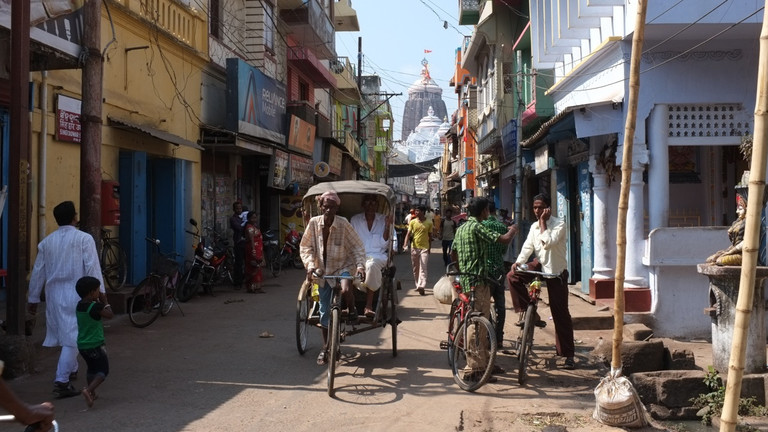COVID-19, JAGA Mission and the value of already existing solutions
Guest blogger Antarin Chakrabarty reflects on one Indian state’s successful programme to provide work and incomes to migrants, enabling a rapid and efficient government response when crises such as COVID-19 hit.


The Odisha state government has distributed land titles to slum dwellers in the temple city of Puri (Photo: Aleksandr Zykov via Flickr, CC BY-SA 2.0)
The COVID-19 pandemic is quite the portrait of Dorian Gray revealed – in it, our cities and their makers can now catch a clear glimpse of the hideous and brutal reality that hides underneath the ‘smart’ and glamorous spatial forms.
While many national and city governments are waging a desperate struggle as health care systems are overwhelmed and with no clear end in sight, it can be argued that the ones that have had a longstanding commitment to health, welfare and inclusive development are faring better.
Soon after India announced its strict lockdown on 24 March, news and images started pouring in of thousands of migrant workers leaving the cities on foot to trek hundreds of kilometres to their villages. Less than a month later, while central government struggled unsuccessfully to come up with measures to address this terrible suffering, the government of Odisha, a state on the eastern coast of India, announced the Urban Wage Employment Initiative (UWEI).
UWEI provided immediate support to migrant and informal labour by giving them employment in well planned and labour-intensive public works projects. Within two days of the announcement, India's Ministry of Housing and Urban Affairs (MoHUA), issued a notice requesting other state governments to follow Odisha’s example.
While there has been substantial interest in the details of the UWEI since then, it is worth asking how Odisha managed to come up with such a well-thought out scheme in so short a time.
The answer to that lies in the state’s longstanding commitment to welfare and inclusive development, with ongoing schemes already putting that commitment into practice: its JAGA Mission, the focus of this blog, aims to grant land rights to slum dwellers in the state.
It is complemented by Mission Basudha, that seeks to provide piped drinking water supply to all households, and Mission Unnati, that manages the convergence of all urban schemes.
JAGA Mission – a unique slum land titling initiative
In October 2017, the Odisha government enacted the ‘The Odisha Land Rights to Slum Dwellers Act’ (PDF) to grant in-situ, heritable and non-transferable land titles to as many as 200,000 households living in 2,000 slums in all 109 small and medium towns in the state.
After the granting of titles, it planned to follow up with a comprehensive slum upgrading process. Odisha had an urban population of about seven million people according to the 2011 census, 23% of which resided in slums.
With a beneficiary coverage of over one million people, JAGA Mission (Jaga means place in the Odia language) is one of the largest slum titling projects undertaken by a regional government anywhere in the world.
The initiative is unique in focusing on small and medium-sized towns rather than only the five large cities of the state – typically, slum upgrading projects tend to focus on large cosmopolitan centres.
While government and private investment concentrate in large cities, the smaller towns lack the capacity to plan for their own growth. Odisha changed this by placing small and medium towns at the centre of the inclusive urban development conversation.
JAGA also created an innovative organisational structure and methodology. Although being driven largely by the state government’s Department of Housing & Urban Development (HUDD) under the leadership of an extremely dynamic principal secretary, the operational parameters of the mission required a wide range of state and non-state actors to participate.
The process combined technology interventions, such as mapping of slums using high resolution drone imagery, with community mobilisation using time-tested participatory strategies.
The mission also created a Slum Dwellers Association (SDA) in each slum to articulate the needs of the residents. By 2018 Odisha had become the only state in India to possess a detailed spatial database of every slum in every city and town within its borders. By late 2019, about 60,000 certificates of land rights were distributed to slum dwellers across the state through the SDAs.
Three years before COVID-19 would threaten to transform life in our cities, JAGA had already started transforming mainstream urbanisation in Odisha.
JAGA morphs into UWEI
Effectively, all that UWEI had to do was to operationalise and add to the public works activities that were already planned under the slum upgrading phase of JAGA.
The upgrading process involved providing support of Rs 200,000 (US $2,900) to each household to rebuild their houses with permanent materials (especially in cyclone prone areas); piped drinking water supply; creation of individual toilets; LED street lighting; and creation of green spaces and community centres.
The various government welfare schemes mentioned earlier funded these public works components (except for the individual house construction support), converging and collaborating to cover all parts of the project.
For example, when JAGA upgrades slums, it does not create a separate component for drinking water supply within its project parameters. Rather, it simply converges with Mission Basudha, which has a dedicated fund of INR 236 crores ($31 million) for providing piped water supply to all urban households as per the state budget for 2020-21.
UWEI added components for monsoon preparedness to the list, such as de-silting drains, installing steel grill filters at outfall points, constructing percolation tanks for rainwater harvesting and creating waterbodies. The scheme forbids the use of machinery for activities like digging tanks, relying instead on manual labour.
Self-help groups and the SDAs formed under JAGA are implementation partners. To speed up the process, work orders are directly issued to municipal engineers without the need of a tendering process.
The UWEI has a budget of INR 100 crores ($13 million). The funds will be provided mainly by Mission Unnati, with the slum related works being funded by Mission Jaga. The initiative will remain in operation for six months (April to September 2020), but even after the scheme is over, the slum upgrading process under JAGA and the other welfare schemes will continue.
Understanding and engaging with what already works
Despite all these efforts, the state is struggling as migrants from other states pour into Ganjam district in the south and Cyclone Amphan smashes through the port city of Paradeep in the north. Still, the geographical spread of JAGA and the systems already in place ensure that UWEI can activate itself in any town of the state and absorb the labour force, all at relatively short notice.
Schemes such as JAGA enable governments to respond meaningfully to structural challenges such as urban poverty and to a sudden crisis like COVID-19. In so doing they offer clues to how we might imagine cities to be in a post-COVID-19 world. It couldn’t be clearer that a thorough understanding of already-existing schemes and active engagement with them is crucial.
In the next two blogs in this series we will hear how the Homeless People’s Federation in the Philippines is responding to the challenge of COVID-19, and will also return to explorations of the social, political and environmental factors that cause cities to thrive or decline, with a blog examining what drives cities’ development trajectories.



